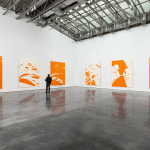Contributed by Sharon Butler and Jonathan Stevenson / Rebecca Morris, a masterly abstract painter who could do pretty if she wanted to, insists that when a painting starts to look beautiful she catches herself on and pivots to more discomfiting territory. That kind of grim integrity and its visual realization has an austere appeal, but there’s no need right now to get into the niceties of infinite regress or meta paradox. Judging by her solo show at Bortolami, parsimoniously titled “#31” after the number of solo shows she has presented during her career, Morris does consciously resist the pursuit of visual beauty and representation. The large-scale oil-and-spray-paint works are all untitled, distinguished only by parenthetical number indicating the year and the order in which the paintings were made. Each canvas is replete with vivid color and divergent shapes but embodies an irresolute and disconsolate state of play. This could ramify for a given viewer in any number of ways – though not, presumably, as lovely.
Tag: Rebecca Morris
Rebecca Morris: Loving the unbeautiful
Rebecca Morris likes to compartmentalize. Her paintings, smartly installed at Mary Boone’s Fifth Avenue location through February 25, feature symmetrically placed geometric shapes, sometimes collaged onto the surfaces of the large-scale canvases. Each of the shapes, large squares or circles,is divided into numerous smaller shapes that have been casually filled with improvised patterns, line, and brushwork. Morris’s paintings at first seem aligned with work by contemporary painters like, say, Trudy Benson, Lauren Silva, or Leah Guadagnoli, who use kitschy elements from ’80s graphics–stepped rules, drop shadows, squiggles, pastel palettes. But rather than evoking the gormless charm of this earlier era, Morris’s abstractions are confrontational and challenging
























